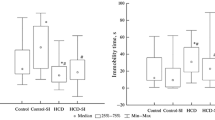Summary
Tree shrew ruffle the hair of their tails in response to certain environmental situations. The single intervals of ruffling during a continuous 12-hour period of observation were added and expressed as percentage of the total observation time [% ruffling = % SST (Sträuben der Schwanzhaare)]. Ruffling of the hair is induced:
-
1.
By stimuli from members of the same species; in this case, two social components have to be distinguished: a) an agonistic one, which is determined by the degree of subordination; b) one, which is solely determined by the number of individuals in the cage.
-
2.
By certain non-social stimuli (such as noise).
As percentage of ruffling increases, whether caused socially or non-socially, the following phenomena appear:
-
a)
Retardation of growth; loss of weight in adults (appears below 20% SST and becomes increasingly pronounced).
-
b)
Male copulatory behaviour of adult females (appears above 20% SST).
-
c)
Lack of protective marking of the newborn by the mother with the consequence that the young are eaten by members of the group (appears above 20% SST).
-
d)
Infertility of the females and retraction of the testes in the males (appears above 50% SST).
-
a)
All these processes are reversible. — The animals die, if SST is higher than 80% for a period of about 10 days.
The hairs are erected by the MM. arrectores pilorum, which are innervated by the sympathetic nervous system. Since hormonal glands (particularly the pituitary and the adrenal glands) take part in any autonomous activation of the organism, we propose on the basis of our results the following hypothesis: The proportion of ruffling (% SST) of a 12-hour period of observation gives a measure for the strength of hormonal stress.
Zusammenfassung
Tupajas sträuben in bestimmten Situationen die Haare auf dem Schwanz. Die Zeiten, in denen die Tiere die Schwanzhaare gesträubt hatten, wurden registriert und ihre Summe in Prozent des 12stündigen Beobachtungstages ausgedrückt (% SST). Sträuben der Schwanzhaare wird ausgelöst:
-
1.
durch Reize, die von Artgenossen ausgehen; dabei sind zwei Komponenten zu unterscheiden: a) eine agonistische Komponente, die vom Dominanzverhältnis bestimmt wird und b) eine Komponente, die allein von der Anzahl der Individuen im Käfig abhängt.
-
2.
Durch nicht-soziale Reize (wie z. B. Lärm).
Mit Zunahme der Prozent SST gehen folgende Erscheinungen parallel:
-
a)
Verzögerung des Wachstums; Gewichtsabnahme bei adulten Tieren (schon bei weniger als 20% SST).
-
b
Männliches Kopulations-Verhalten von adulten Weibchen (ab ca. 20% SST).
-
c)
Ausbleiben der Schutzmarkierung der Neugeborenen durch die Mutter (ab ca. 20% SST).
-
d)
Unfruchtbarkeit der Weibchen und Hodenretraktion bei den Männchen (mehr als 50% SST).
-
a)
Diese Erscheinungen sind reversibel. — Die Tiere sterben, wenn mehr als 80% SST über einen Zeitraum von etwa 10 Tagen vorhanden ist.
Die Schwanzhaare werden durch die MM. arrectores pilorum aufgerichtet, die vom sympathischen Nervensystem innerviert sind. Da Hormondrüsen (vor allem Hypophyse und Nebennieren) an jeder Aktivierung des Organismus beteiligt sind, stellen wir auf Grund unserer Ergebnisse folgende Hypothese auf: Der Prozentwert von SST gibt uns ein Maß für die Stärke des hormonalen Stress.
Similar content being viewed by others
Literatur
Barnett, S. A.: Social Stress. The concept of stress. In: Viewpoints in biology, vol. 3, p. 170–218. London: Butterworths 1964.
Bixenstine, V. E.: A case study of the use of palmar sweating as a measure of psychological tension. J. abnorm. soc. Psychol. 50, 138–143 (1955).
Christian, J. J.: The adreno-pituitary system and population cycles in mammals. J. Mammalogy 31, 247–259 (1950).
—: Endocrine adaptive mechanisms and the physiologic regulation of population growth. In: Physiological mammalogy, vol. 1, p. 189–353. New York and London: Academic Press 1963.
Hess, E. H., and J. M. Polt: Pupil size as related to interest value of visual stimuli. Science 132, 349–350 (1960).
Kaplan, R.: Rat basal resistance level under stress and nonstress conditions. J. comp. physiol. Psychol. 56, 775–777 (1963).
Kawa, A., T. Kanehisa, T. Ogawa, S. Takeda, Y. Inamori, and O. Okamoto: Experimental studies on the relationships between emotionality, cardiac functions and catechol bodies in rats. Acta med. Univ. Kagoshima. 8, 157–167 (1966).
Koster, R.: Hormone factors in male behaviour of the female rat. Endocrinology 33, 337–348 (1943).
Lazarus, R. S.: Psychological stress and the coping process. New York and London: McGraw-Hill Book Co. 1966.
Martin, B.: The assessment of anxiety by physiological behavioral measures, Psychol. Bull. 58, 234–255 (1961).
Martin, R. D.: Tree shrews: unique reproductive mechanism of systematic importance. Science 152, 1402–1404 (1966).
Mason, J. W.: Psychological influences on the pituitary-adrenal cortical system. Recent Progr. Hormone Res. 15, 345–389 (1959).
Sayers, G., and M. Sayers: The pituitary-adrenal system. Ann. N.Y. Acad. Sci. 50, 522–539 (1949).
Selye, H.: The general adaptation syndrome and the diseases of adaptation. J. clin. Endocr. 6, 117–230 (1946).
—: The physiology and pathology of exposure to stress. Montreal: Acta 1950.
Spielberger, C. D. (ed.): Anxiety and behavior. New York and London: Academic Press 1966.
Author information
Authors and Affiliations
Additional information
Mit Unterstützung der Deutschen Forschungsgemeinschaft.
Rights and permissions
About this article
Cite this article
Autrum, H., von Holst, D. Sozialer „Stress“ bei Tupajas (Tupaia glis) und seine Wirkung auf Wachstum, Körpergewicht und Fortpflanzung. Zeitschrift für vergleichende Physiologie 58, 347–355 (1968). https://doi.org/10.1007/BF00343508
Received:
Issue Date:
DOI: https://doi.org/10.1007/BF00343508



